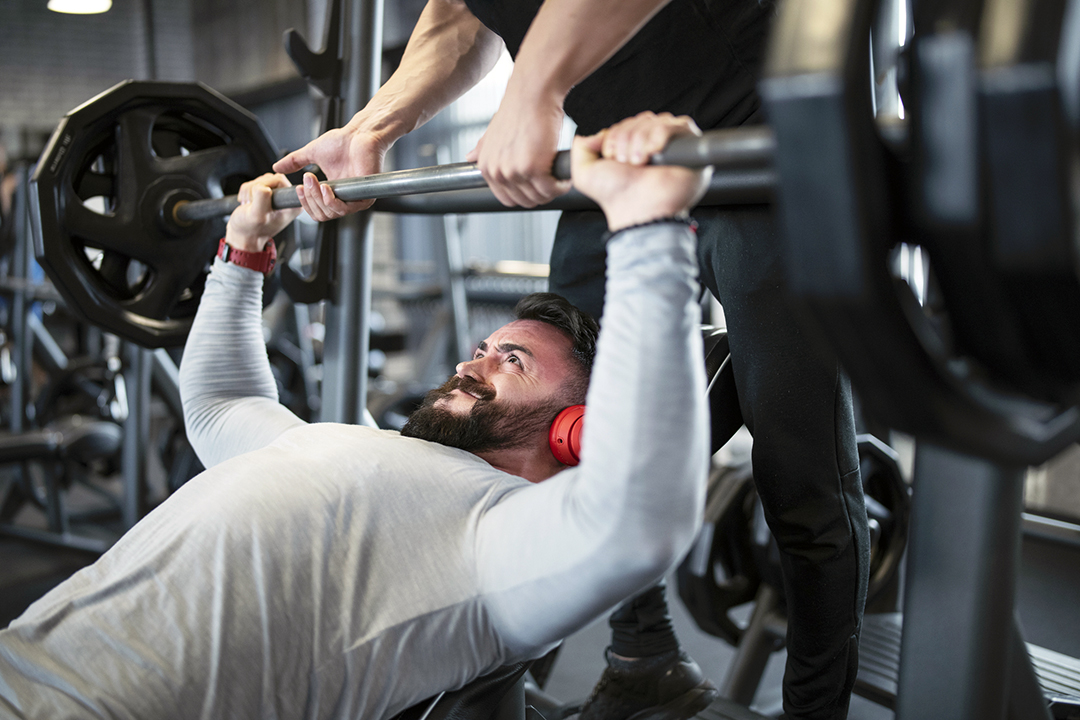If you want to build substantial strength or lasting muscle endurance, guesswork doesn’t cut it. You need a strategic, focused strength training plan that will help you get fit with fast and reliable results. In the past, the rule has been that lifting light weights with more reps helps increase muscle tone and endurance, while lifting heavy weights with fewer reps will increase strength and size. This strength training methodology has guided many workout plans in the past, as well as sparked some heated debates among athletes and researchers alike.
So, what’s the final verdict? Is it better to do more reps? Or lift more weight? Let’s find out the best method for you, based on your strength training goals.
Power & Mass: Focus on Low Reps with Heavier Weight

If growing muscle mass is your biggest goal, low reps with heavier weight is the traditional method. You’ll grow your strength over time by increasing the amount of weight your body can lift. In some cases, you may only do 1-5 reps with a single weight that’s at the top of your one-rep lifting ability (90-95%).
When you focus on heavier weights, you build “fast-twitch” muscle fibers. These muscle fibers are needed for strength and growth, making them the key fibers to focus on if you want to grow your muscle mass or increase your power.
But, fast-twitch fibers have a downfall – they fatigue quickly. On top of that, they only grow in relation to how long they are stimulated. This means that if the muscle fatigues too soon and you don’t hold the life long enough, it won’t grow.
To prevent this, do slightly more reps with a lighter (but still heavy) weight. Aim for 8-12 reps at 70-75% of your one-rep lifting capacity). This allows you to hold your lift long enough to achieve strength and growth without fatiguing the muscle too soon.
Tone & Endurance: Focus on High Reps with Lighter Weight

Lifting weights is not just about growing strong and big. There’s a lot to be said for endurance, muscle tone, and overall fitness, too.
For those who want to focus on getting fit, burning fat, and improving their strength and endurance, doing high reps with less weight is usually the best method. Doing 15 reps or more per set, at a weight that is only 50-60% of your one-rep maximum, is the typical way to practice high reps, low weight. But, studies show that 8-12 reps tends to be more of a muscle-building sweet spot.
In contrast with the low-reps, high-weight method, this method activates “slow-twitch” muscle fibers. Slow-twitch fibers are less powerful than fast-twitch fibers, but they are slower to fatigue. Activating these fibers allows you to perform more reps and develop greater muscle endurance. High-rep, low-weight workouts are also better for fat burning and body sculpting.
Beware the Fitness Plateau

No matter which weightlifting strategy you choose to pursue, there is one issue you can’t ignore: the fitness plateau.
A fitness plateau is when your body stops progressing, despite working out regularly. The problem? Your fitness program isn’t varied enough, and your body adapts to the same old routine. This can happen whether you focus on more reps, more weight, or even one specific type of exercise in general.
The key to getting out of the fitness plateau rut is to change things up drastically. Switch up your routine or try something new. Make sure your workouts make you “feel the burn” and try activating new muscle groups. Then, switch back to your favorite workouts and keep reaching new heights.
Balanced Strength: The Best of Both Worlds
You want to be strong and powerful, but you also want excellent endurance and fitness. So, why not get the best of both worlds? Strength training doesn’t have to be one way or the other. In fact, those who practice both weightlifting methods benefit from balanced strength and better overall fitness in the long run.

Consider alternating methods either every other workout, every other week, or every 6-8 weeks rather than focusing on one method entirely. Whatever your fitness plan, be sure to keep it consistent and alternate regularly to prevent uneven muscle development.
The Benefits of a Balanced Strength Training Routine
- Alternating low rep high weight training with high rep low weight training allows the muscle tissue and nervous system to recover and heal from heavy lifting.
- Alternating methods can reduce the risk of overuse, issues with your form, and injuries.
- Using both methods helps to avoid a fitness plateau and keep progressing faster.
3 Easy Ways to Build Strength Outside the Gym

The real secret to the best strength training or weightlifting routine? Growing strong and powerful doesn’t just happen in the gym. You need a lifestyle that supports and boosts all the hard work you put in during training. Without these steps, you could find yourself stagnant, slow-to-progress, or worse – injured and on the sidelines.
1) Give your body the right fuel.
If your body is like a car, food is your fuel. Make sure the energy you put in will translate to powerful energy output. Eating foods that support healthy muscle development, body composition, and intense workouts is essential for making big gains and avoiding burnout.
The best diet for building muscle? Well, there’s no one-size-fits-all. Most people do well on a high-protein, high-healthy fat diet, and there are endless bodybuilding, hypertrophy, or lean muscle diets out there. For the best results, talk with your doctor or AlignLife Chiropractor to make the best choice for your body and lifestyle. You can also grab Aceva’s Peak Protein to up your daily intake of protein. Peak Protein is an easy-to-mix, great-tasting vegetable protein with 20g of bioavailable protein and 4g of fiber.
2) Recover with strategic supplements.
Weight training is hard on the body, so let’s ensure we take every step to reach the best results and rapid recovery. A muscle maintenance supplement like creatine or protein powders will help maximize your workouts, repairs muscle tissue, and enhances your athletic performance.
3) Eliminate pain and enhance performance with chiropractic care.
Nothing keeps you from reaching your goals like nagging pain and injuries. Unfortunately, these tend to be part of living an active life, especially for weight trainers.
The good news is that you don’t have to let pain, soreness, or injuries stop you. Chiropractic care excels at treating athletic pain and injuries naturally. Regular chiropractic care also correlates with enhanced strength, mobility, and performance to help you go even further with your fitness goals.
Focused Care for Focused Athletes

Are you ready to hone your strength training routine and finally see the progress you know you’re capable of? Deciding how to balance your training is just the start. Real progress happens with a focused care plan and approach.
Stop guessing and start focusing. Book a visit with your local AlignLife Chiropractor today to get the focus, strategy, and support you need for lasting strength and endurance.



